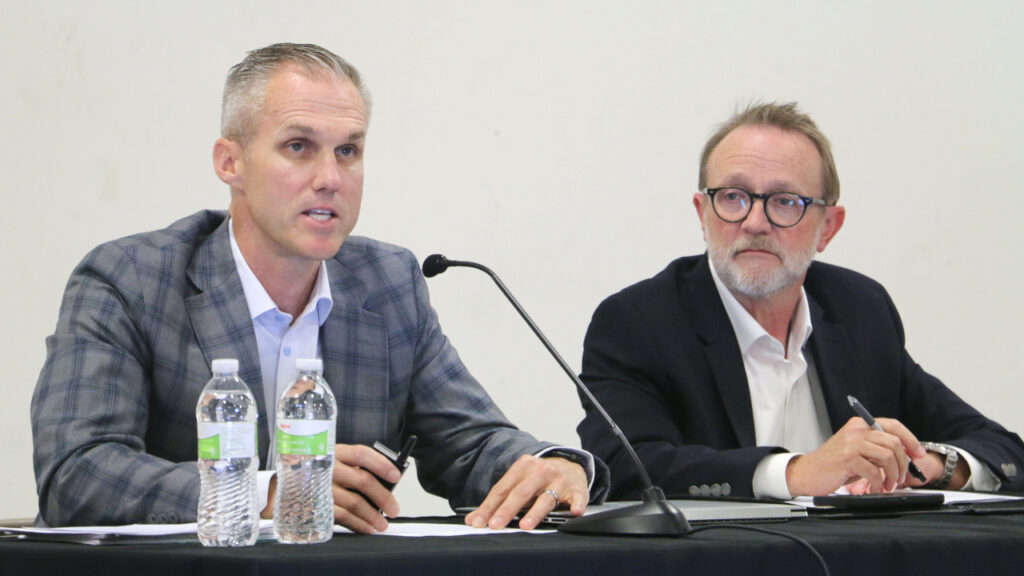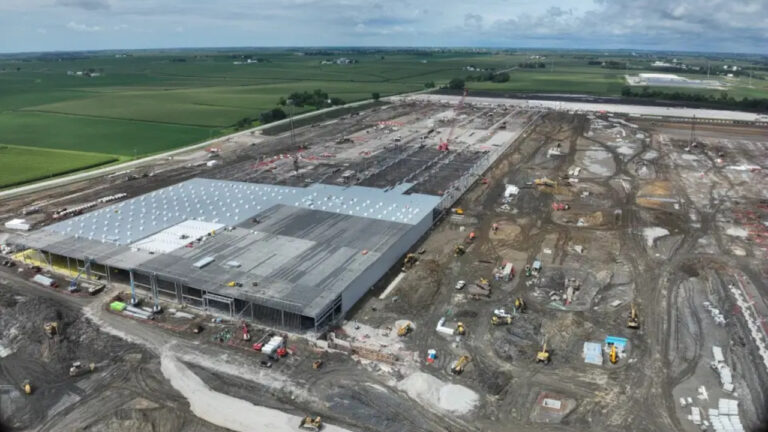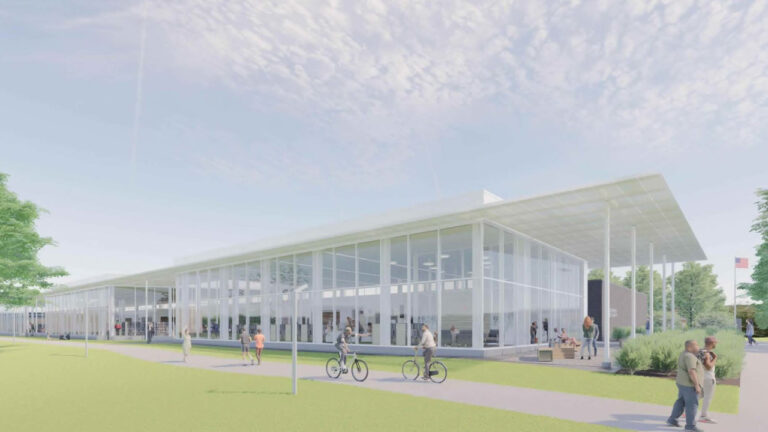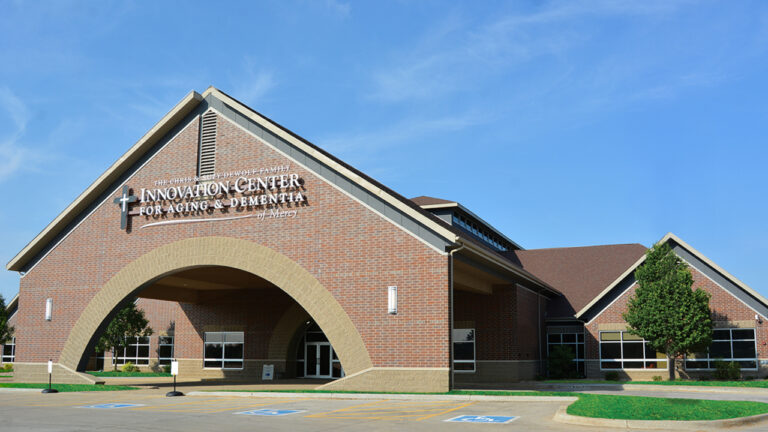From water usage and environmental concerns to economic impact and job creation, local residents shared their views Thursday night, Nov. 13 at an informational meeting hosted by the Iowa Utilities Commission (IUC) on the proposed restart of the Duane Arnold Energy Center near Palo.
About 60 people attended the meeting at the Hawkeye Downs Expo Center in southwest Cedar Rapids.
The meeting was held as a procedural step in the IUC’s consideration of a certificate of public convenience, use and necessity for the plant – one of a host of local, state and national steps that must be approved before the plant can be authorized to restart.
The proposed restart was propelled last month, when NextEra Duane Arnold LLC, the legal entity pursuing the plant’s restart, announced a power purchase agreement with Google, under which the tech company would purchase the majority of the power produced from a restarted Duane Arnold. Importantly, however, that announcement does not mean the plant is guaranteed to restart, as several regulatory hurdles remain.
The 615-megawatt Duane Arnold Energy Center was shut down after the August 2020 derecho brought 140 mph winds that heavily damaged the plant’s cooling towers and other infrastructure, NextEra Energy officials said.
Prior to the storm, the plant was scheduled to be decommissioned in October 2020 after its main customer, Alliant Energy, paid $110 million in 2018 to exit its power purchase agreement with the plant five years earlier than planned. At the time, Alliant spokesman Justin Foss said the deal for early decommissioning of Duane Arnold came about as a result of discussions on extending the utility’s power purchase agreement (PPA) with the plant. The power prices quoted by NextEra did not seem appealing for Alliant’s customers, Mr. Foss said.
However, rising power demand, spurred in large measure by the rapid development of data centers and other power-hungry enterprises, have led NextEra Duane Arnold to pursue the plant’s restart.
At Thursday’s meeting, NextEra officials in attendance – including licensing manager Mike Davis and executive director of nuclear development Josh Marcum – said they hope to restart the plant in late 2028 or early 2029.
They also said that aside from the plant’s electrical power output, it would provide a host of economic benefits. They cited a report produced by Strategic Economic Research showing the plant would bring 1,640 Iowa jobs during construction and nearly 400 ongoing full-time jobs at the plant; $8.2 billion in economic impact to Linn County during construction and a subsequent 25-year operating period; and $50 million in sales tax for the state of Iowa.

During the meeting’s question-and-answer session, those economic benefits were echoed by Ron Corbett, vice president of economic development for the Cedar Rapids Metro Economic Alliance, who equated the plant’s economic impact to the devastation of the 2008 flood.
“Cedar Rapids and Iowa City were impacted the most (by the flood),” Mr. Corbett said. “Our impact on that 2008 flood was $5.4 billion, and for the whole state of Iowa was $10 billion. That was a $10 billion disaster. So when you think of a $9 billion positive economic impact, you can see why we are so supportive of it.”
Jon Van Zante, business manager for IBEW, expressed his union’s support for the restart.
From what we can tell, the restart will create nearly 400 well-paying permanent jobs and will support over 800 jobs during construction, many of which will go to members of organized labor,” Mr. Van Zante said. “The benefits from bringing the facility back online will be plentiful. Over $320 million will be injected into our economy yearly, and schools and community resources will receive millions in tax revenue.”
However, some speakers raised concerns about the plant’s water usage and environmental impacts.
Rich Patterson, who served 36 years as director of the Indian Creek Nature Center in Cedar Rapids before retiring in 2014, said he was worried about the amount of water a restarted Duane Arnold Energy Center would require from the Cedar River, especially considering the additional water demands of the new Google data center under construction south of Cedar Rapids.
“I recognize that the plant did use a lot of water when it was operating, which it’s not using now. “You’re going to go again taking water from the river,” Mr. Patterson said. “We have droughts. I remember 1988. There will be droughts. We are going to want to drink water and make coffee and take showers. I would ask you to get good information on how much water the plant itself is going to take, combined with how much water Google is going to take, superimpose that on a drought and give us good information on how that’s going to affect our lives.”
“There’s an aquifer underneath this area,” added Susan Biederman of Cedar Rapids. “Are you going to be pulling water from that too, besides the Cedar River?”
“For the plant cooling, we only pull from the Cedar River,” Mr. Davis responded. “We have some internal processes that use well water, but those are much smaller amounts than what we pull from the river.”
Pam Mackey Taylor of Marion, director of the Iowa chapter of the Sierra Club, expressed several concerns about the project, from its environmental impact from operations to its use of uranium, a finite natural resource.
“Nuclear power is not clean energy,” Ms. Mackey-Taylor said. “The mining and processing of uranium leaves tailings and other radioactive waste during operation of a nuclear plant. Radioactive material is emitted, primarily tritium, which is emitted into the air and into the groundwater. The worst problem is the radioactive waste after the fuel rods have been used. There are many thousands of tons of radioactive waste across the country, and there’s no good solution for what to do with it.”
The spent fuel from Duane Arnold, as with other nuclear energy facilities nationwide, is stored on-site in steel canisters inside reinforced concrete bunkers.

Ms. Mackey-Taylor also said Iowa law “clearly supports the transition to renewable energy like wind and solar,” and questioned Google data centers’ need for nuclear power.
“The QTS data center being constructed in Cedar Rapids says it will be powered by just renewable energy,” she said. “So why can’t Google do the same with its proposed projects?”
The comments at Thursday’s meeting were not entered into the official IUC docket for the proposed Duane Arnold restart, but comments can be filed to the docket electronically or by mail.
The IUC’s decision on the application for a certificate of public convenience, use and necessity will be made after IUC staff reviews submitted comments and NextEra application materials. No specific date for the decision has been announced.









